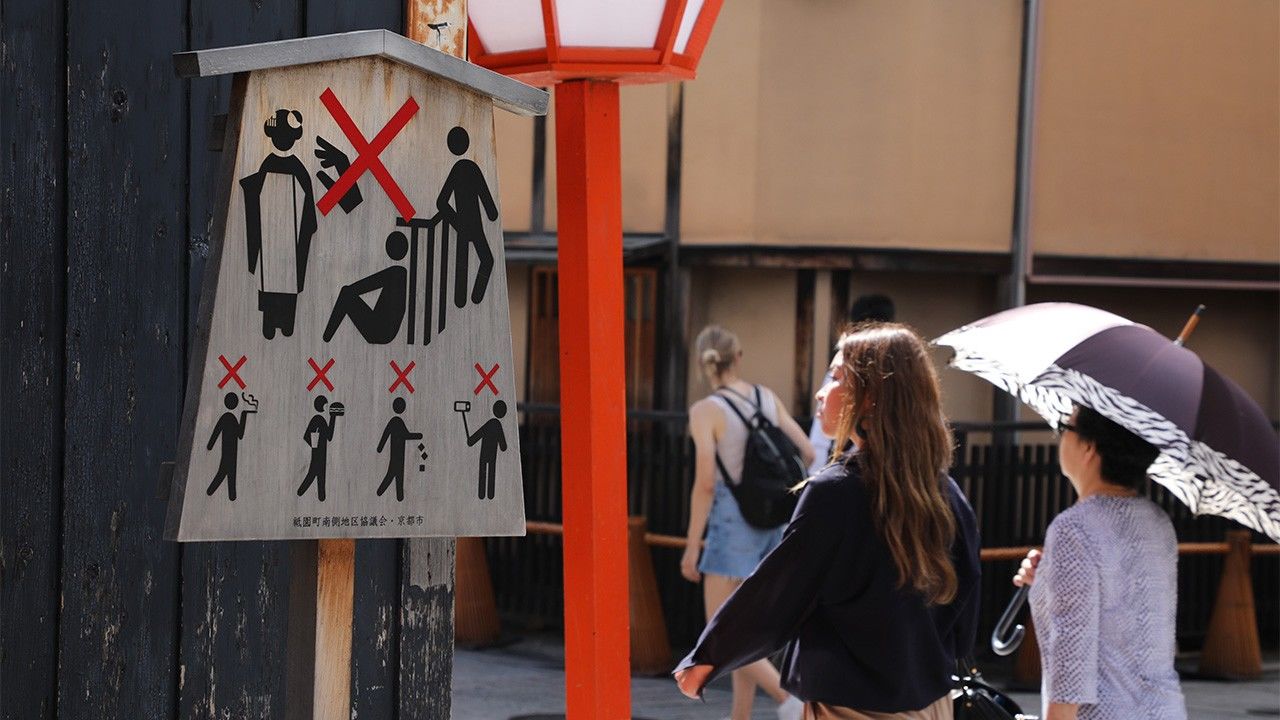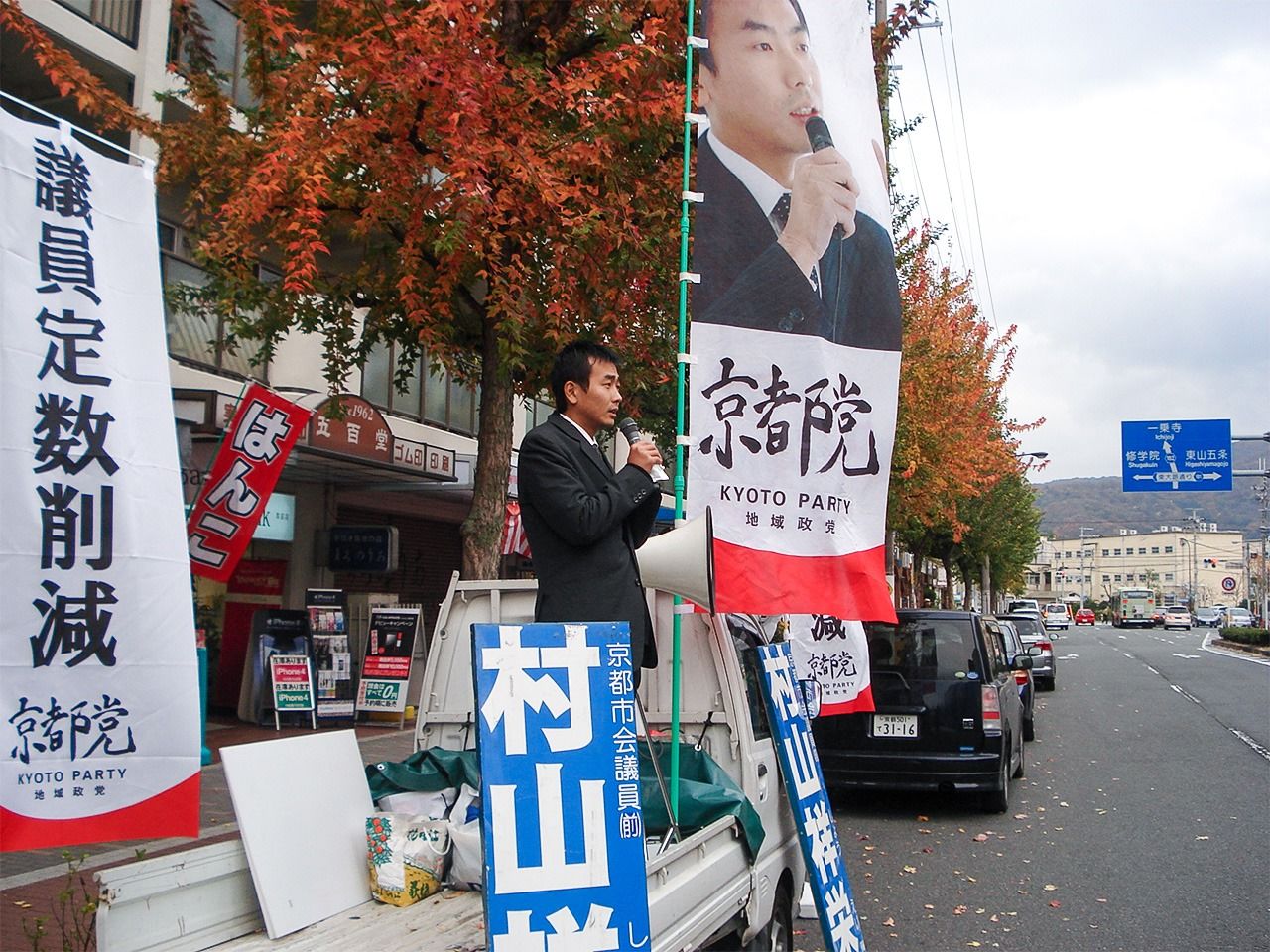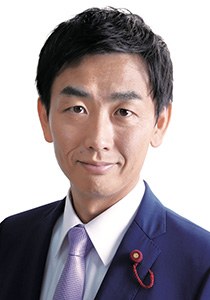
Kyoto and the Peril of Overtourism: Interview with Mayoral Candidate Murayama Shōei
Politics Society Travel- English
- 日本語
- 简体字
- 繁體字
- Français
- Español
- العربية
- Русский
Ancient Capital, Global Destination
On February 2, Kyoto residents will vote to elect their mayor. Leading up to the election, one relatively new issue has become salient: how to deal with the challenges of overtourism.
The ancient capital and global tourist destination has been transformed in the past decade by a surge, some might say an alarming flood, of tourists. From 2008 to 2018 the number of foreign visitors to Japan quadrupled to 31 million annually, while inbound travelers to Kyoto soared from 500,000 to over 8 million. Including Japanese visitors, 52 million people visited Kyoto in 2018, spending an estimated ¥1.3 trillion (the city’s nominal GDP was ¥6.3 trillion in 2016) on lodging, food, shopping, and sightseeing. A little more than a third of these nonresidents stayed overnight, swelling Kyoto’s population by an average of 15%.
But too much and too rapid an influx has generated many visible side effects: public transport overflowing with backpackers and suitcase-wielding travelers; photo-snapping tourists chasing geisha over cobble-stoned streets; littering and loitering in temples and shrines; vacation rentals disrupting quiet residential areas. Japanese tourists have begun to avoid Kyoto altogether, with 7 million less visiting annually since the number peaked in 2015.
Less immediately visible are the nefarious dynamics of “tourism gentrification.” Locals are being squeezed out of property markets as the city’s real estate prices soar due to hotel and investments in second homes, while shops and services catering to locals are crowded out by those targeting tourists.
Unsurprisingly, the questions of how authorities in Kyoto should deal with the mounting issue of kankō kōgai (literally “sightseeing pollution”) has become a vital one. Japanese media are increasingly reporting on how tourist-swamped European cities like Venice, Amsterdam, and Barcelona have seen demonstrations and boycotts, followed by increasingly stringent local regulations and levies against visitors. Could the 1,000-year old ancient capital of Japan be next?
On December 15, I sat down to talk about overtourism with Murayama Shōei, former city Kyoto assembly member and founder of a local party. Murayama, who recently published the book Kyōto ga kankō de horobiru hi (How Overtourism Will Destroy Kyoto), is standing for the upcoming mayoral election. Reforming tourism is a central plank of his campaign.
“Kyoto has been too slow in dealing with the drawbacks of tourism and investing in necessary infrastructure,” says Murayama. “Overtourism has reached an unprecedented level. And if it continues, more Japanese visitors will avoid Kyoto, while residents’ hostility towards tourists will only increase.”

Murayama Shōei campaigning in Kyoto. (Courtesy the office of Murayama Shōei)
The Mess of Minpaku
Murayama points out in his book that Kyoto has long been a pioneer of modern-style tourism. It opened the country’s first tourist information booth at Kyoto Station in 1927 and established its tourism division three years later. It is only in the last few years that problems have become so prominent.
A major trigger of tensions with residents had been the sprouting of minpaku, private residences rented to short-term lodgers, across the city, prompted by the appearance of broker sites like Airbnb. Not only were property owners renting out rooms in their own homes, but developers and investors were piling into the market, purchasing whole apartment buildings and renovating residences solely as vacation rentals.
Formerly contained in tourist spots and commercial areas, visitors were now spilling into residential neighborhoods. Murayama explains that residents were soon complaining about tourists dragging suitcases through quiet streets to get to their rentals or mistakenly ringing doorbells at night. Investor-owners not joining or contributing to local neighborhood associations was another common grumble.
Kyoto responded forcefully to these complaints. In 2017, it passed strict bylaws—what Murayama describes as “ultra-C” (a Japanese idiom for something extremely ambitious)—for Airbnb-style accommodation and simple lodgings. These included restricting minpaku in residential areas to only two months from January to March (more stringent than the 180-day maximum annual limit set by national law). Additional bylaws require that vacation rentals have a manager stationed nearby or present on a 24-hour basis.
Although the abrupt regulatory shift forced out some smaller owners who were unable to comply, Murayama lauds the way the city officials dealt with unregulated informal accommodation.
“I think Kyoto stood on the side of residents and effectively excluded minpaku to restore their normal daily lives,” he says.
Hotel Rush
Less successful has been the local government’s approach toward hotel construction, judges Murayama.
Only last November did the current mayor state at a press conference that the city was no longer unconditionally encouraging the building of new hotels. Until then the city government had proclaimed a shortage of rooms and set ambitious targets to attract hotels, triggering an unprecedented rush. Since 2016, the number of hotel rooms in Kyoto has increased by some 1.5 times to over 46,000, as of March 2019.
“Since the return rate on capital is higher for hotels than apartments or office buildings, hotel developers have been snapping up available land all over the city. The rate of increase of Kyoto’s commercial land prices has topped that of even Tokyo, becoming Japan’s highest,” says Murayama.
The city’s strategy of leasing municipal land in prime areas, including sites of former elementary schools, to Tokyo-based and foreign hoteliers and developers has also been feeding this trend. Some residents have decried the privatization of these historical schools, which were founded in the Meiji era (1868–1912) through neighborhood donations. Others have voiced concern about losing access to spaces that served as evacuation centers during natural disasters.
From a broader perspective, the hotel rush, along with investment in second homes and apartments, has come with an “opportunity cost”: the expense of building much needed apartments and offices to grow the city, Murayama explains.
A Shrinking City
Despite its construction boom and glut of tourist-driven consumption, Kyoto is one of the few of Japan’s 21 largest cities experiencing population decline. In the five years from 2015 to 2019, the number of residents fell by 0.6% to 1.47 million. In contrast, many municipalities around Kyoto—especially in neighboring Shiga Prefecture—have seen population gains. Much of this, Murayama explains, is a result of a steady exodus of young families looking for more affordable housing outside of Kyoto.
A lack of attractive jobs has meant many of the students at Kyoto’s numerous universities leave after graduating. One factor has been the relatively high cost and lack of office space, analyzes Murayama, for companies and start-ups to set up shop in the city.
“You may think that Kyoto is a city of tourism, but in fact it only comprises some 10 percent of the city’s industrial structure. Unlike the hospitality-centered economies of Hawaii or Okinawa, Kyoto has a host of manufacturing, service, and real estate companies,” explains Murayama.
“Certainly, encouraging tourism is not a mistake for the Japanese government or for the prefecture, particularly to stimulate growth in rural areas with few industries, but Kyoto is a very large city with potential for other industries.”
More problematic, Murayama points out, is that the tourism boom has not led to higher wages as many of the jobs generated, such as at hotels and restaurants, are nonregular positions. Reflecting this, local government revenues have not increased, but fallen from 10 years ago, and Kyoto’s level of reserve funds is among the lowest for designated cities. The city’s finances are also disadvantaged by the fact that its host of temples and shrines do not pay any local taxes on their properties or on income from entrance fees for visitors.
All of these trends have convinced many Kyoto residents that tourism is not working for them. According to a survey in the June 18, 2019, edition of the Kyōto Shimbun, 70% of residents feel the city should restrict the number of tourists. One respondent’s comment cut to the chase: “Kyoto is coasting on its brand and there is no adequate infrastructure to accept tourists. Even though increased tourism may generate growth, locals don’t feel the benefits.”
Making Tourism Work
The candidates in Kyoto’s upcoming mayoral election are proposing an array of policies to address these local frustrations. To alleviate chronic congestion on main bus routes, Murayama suggests the city invests in a new loop subway around the city connecting Kyoto Station to the Gojō, Gion, Demachiyanagi, Kitaōji, and Nishiōji areas. The new line can be funded, says Murayama, by using revenues from the new “hotel tax” for visitors introduced by the city in 2018, which generated some ¥4 billion in 2019.
Murayama also argues the need for beneficiaries of the recent tourist boom, including temples and shrines, to pitch in more toward developing tourism infrastructure.
“There has always been a strong underlying sentiment among locals that temples and shrines should be taxed. But it has become a taboo issue since Kyoto ultimately failed to do this in the 1980s,” explains Murayama.
In 1985, Kyoto passed the so-called ancient capital tax (kotozei) of ¥50 on entry fees at temples and shrines. In protest, major temples closed their gates to sightseers, and tourist figures subsequently plummeted. After a two-year stand-off, Kyoto repealed the tax. Ever since, relations between the city government and local religious organizations have been strained, Murayama explains.
“But it’s time to revisit the issue now that overtourism has become such a prominent topic. The temples recognize that tourism is causing trouble for local residents and are gradually realizing they need to contribute toward improving the situation. We need to discuss how these entities should support the infrastructure necessary to deal with tourists.”
Beyond Kyoto
Public discussion about regulating and sharing the costs and benefits of tourism, long overdue in Japan, is finally beginning in Kyoto and other areas as the country braces for record numbers of foreign tourists drawn by the Tokyo Olympics.
The administration of Prime Minister Abe Shinzō has set the goal of welcoming 40 million foreign visitors to Japan in 2020, and hopes to raise that to 60 million in 10 years’ time.
In response to such ambitious targets, critics have been calling for Japan to evolve away from an anachronistic model of mass tourism focused on maximizing visitor numbers and processing them through famous sites. Many prominent figures, East Asian arts and culture expert Alex Kerr among them, are arguing that Japan needs to more effectively manage traveler numbers, better protect natural and traditional heritages, and promote high-end tourism that attracts fewer, but wealthier, travelers.
There is some halting progress towards this, as seen in measures to raise entrance fees and limit visitors to prominent cultural sites. Another positive development has been the successful promotion of less prominent tourist sites and regions to disperse crowds throughout Japan. Spending by overseas visitors in rural prefectures has been increasing rapidly and comprises about 30% of overall tourist spending as of 2018.
Local governments are also becoming bolder in raising revenues through new local taxes targeting tourists. Municipalities like Nara, Niseko, Sapporo, and Kitakyūshū have plans to introduce accommodation taxes for those staying in paid lodgings following the recent examples of Osaka and Kyoto. Municipalities like Hatsukaichi (home to Miyajima Shrine) in Hiroshima Prefecture and the Okinawan island of Taketomi are introducing entry fees for tourists, with the revenue then being used to bolster infrastructure to deal with greater visitor numbers.
Promisingly, the central government has been relatively permissive of local government initiatives to introduce new taxes or bylaws around tourism, as has been the case with the hotel tax in Kyoto and stricter regulations on Airbnb-style accommodations.
Finding Fellow Travelers
The debate and legal framework on tourism has reached a turning point in Japan. And the discussion is broadening out to the public in the arena of local politics, albeit slowly.
“It has been quite difficult to make overtourism an electoral issue, as there’s a strong gap between those who are immediately affected by visitors—such as people in neighborhoods with popular sightseeing spots—and everybody else,” explains Murayama.
“And though there are a handful of individual assembly members focused on the issue, I don’t see clear differences across parties over the issue. Even in the upcoming mayoral race in which tourism has become an electoral issue, candidate positions tend to be blurred.”
Overtourism is now an unavoidable political issue. Local representatives and voters will need to engage with issues of how to balance the interests of tourists, industry, and residents. The coming Kyoto election results will be a first step towards seeing how Japanese communities answer this tricky question.
(Originally written in English. Banner photo: A sign in Kyoto’s Gion district warns tourists about inappropriate sightseeing behavior. © Jiji.)
